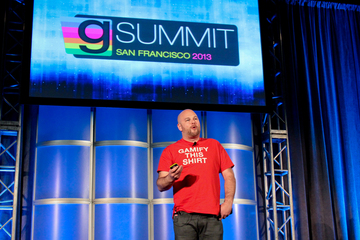
 |
| Gabe Zichermann |
Gamification is a trending topic, and for good reason. Many big firms are adding game mechanics![]() to their processes or applications, with more than 70 percent of the world’s biggest 2,000 companies expected to deploy at least one gamified application by the end of 2014.
to their processes or applications, with more than 70 percent of the world’s biggest 2,000 companies expected to deploy at least one gamified application by the end of 2014.
The core power of gamification is its ability to incentivize and build loyalty among customers because they are more deeply engaged. Here are some examples where gamification can be effectively applied:
Gamification with valued learning. Consider the LevelUp for Photoshop campaign from Adobe. This campaign was a series of levels and missions that helped people learn some basic capabilities of Photoshop during the standard 30-day trial. It introduced gamification into a daunting program in order to help novice users see the vast potential of Photoshop. [What is Gamification?]
Find the distractions. Spot the situations where attention spans are short. Use data/analytics or your own intuition to find areas in your processes or service![]() where the average consumer will simply run out of patience. And remember: People’s attention spans are getting shorter and shorter. Find the areas where people are losing interest, and then work in a level of gamification to keep the consumer engaged long enough to move to the next stage.
where the average consumer will simply run out of patience. And remember: People’s attention spans are getting shorter and shorter. Find the areas where people are losing interest, and then work in a level of gamification to keep the consumer engaged long enough to move to the next stage.
Sharing via social media. In today’s connected world, the power of a customer sharing or recommending a product can be as powerful as a sale. This shifts the focus of gamification toward social channels, instead of simply offering a discounted price or similar incentive.
Offline gamified experiences. Gamification can be brought offline. For example, retail stores can partner with Foursquare, which is fundamentally a gamification platform where people can earn recognition for their check-in locations and frequency. Brick-and-mortar stores can adopt a similar gamification strategy, in which they can blend both virtual and in-person actions into the game mechanics.
Improve customer-loyalty programs. Simple punch-card-style loyalty programs can use a jolt of gamification so they aren’t just a “Buy 10, Get One Free” offer, for example. Gamification is a new framework, moving from giving people free stuff for repeat purchases to creating a system of earning things that results in more frequent brand interactions. Such a system is cheaper than a loyalty program and builds a base of long-term customers.
Progress, not winning, is the goal. Many people who engage in app or online-based games are more interested in proficiency than “winning” the game. They want to master the game. The consumer wants to feel in control of something about your brand, and well-designed gamification can drive![]() this desire for mastery.
this desire for mastery.
Consider longer-form games. Longer-form games that require practice and skill are especially effective for brands when they are trying to increase the frequency of purchases, where ongoing rewards/incentives can drive repeat purchases. Such games need to be more complex, with enough visual and mechanics variety to keep the user playing.
Get off the discount train. Consumers’ dependence on coupons and discounts can be a challenge for businesses. Gamification can help stop the trend toward always-steeper discounts. Consider a car-repair shop. Expand your thinking, and imagine the shop as more than just a place where cars are literally fixed, and instead view the car as part of a journey. Design a game experience around this (taking the kids to school, driving![]() the 50 states), and make that game part of the rewards program.
the 50 states), and make that game part of the rewards program.
Marketing managers always follow the latest trend and understand that if they aren’t learning about important developments, such as gamification, then they are falling behind the competition. Smart marketers understand gamification works best when it’s executed well, whether it’s a full-fledged gamified experience or the insertion of a few game mechanics to help onboard or engage. In either case, gamification can’t just be a simple task-reward process; it needs to be immersive and engaging in order to produce results.
About the author
Gabe Zichermann is the chairman of the upcoming GSummit (June 10-13, 2014), where top gamification experts across industries will gather to share knowledge and insight about customer and employee engagement and loyalty. He is also an author, highly rated public speaker and entrepreneur whose latest book, “The Gamification Revolution,” looks at how leaders are leveraging gamification strategy to defeat their competition.
Originally published on Business News Daily.